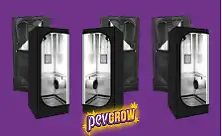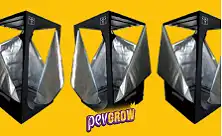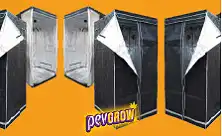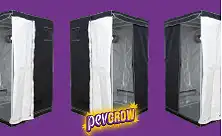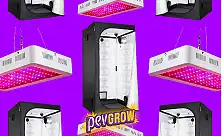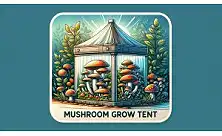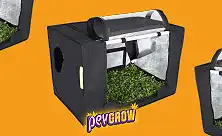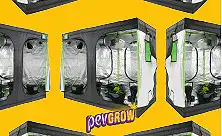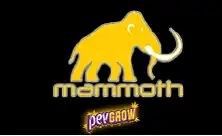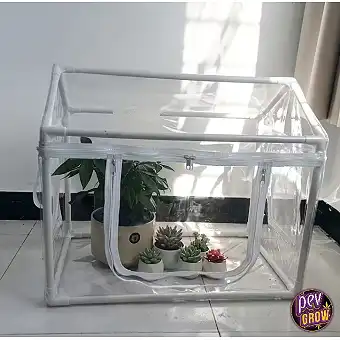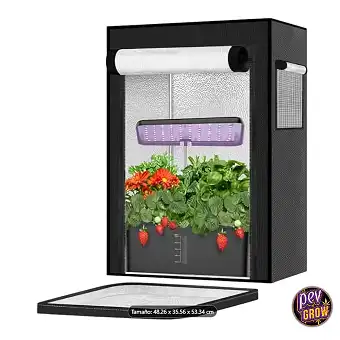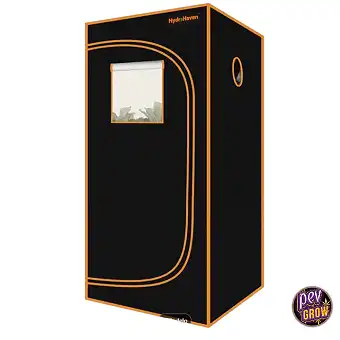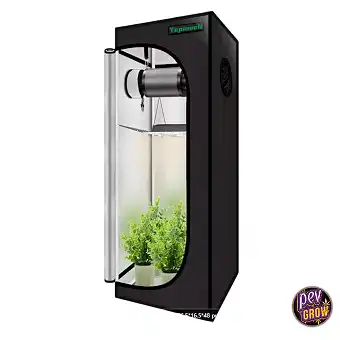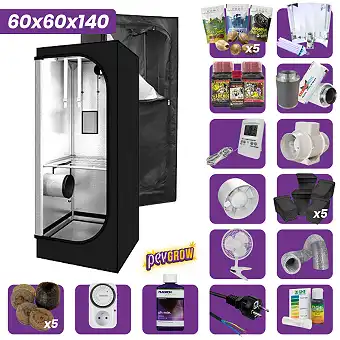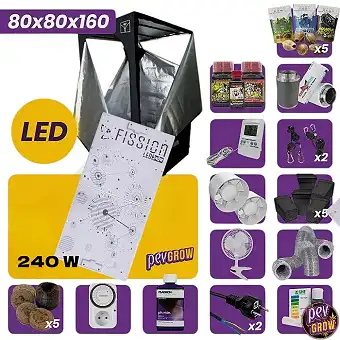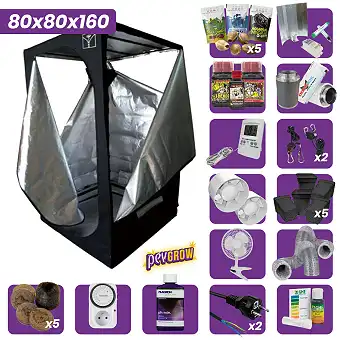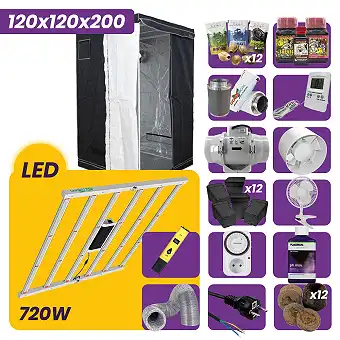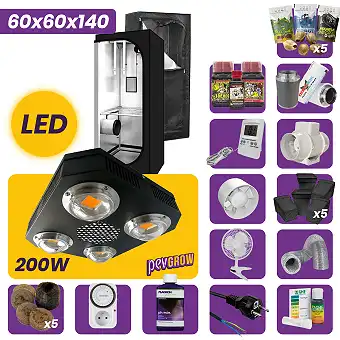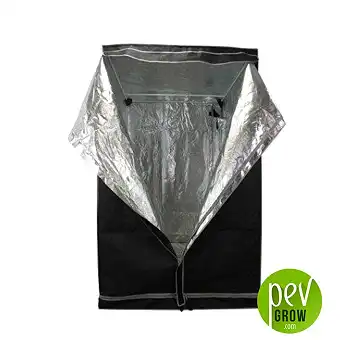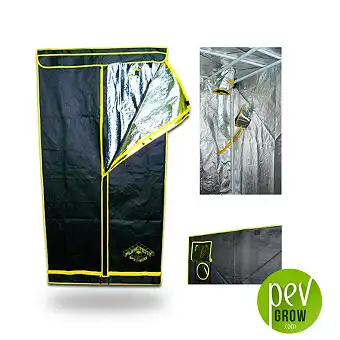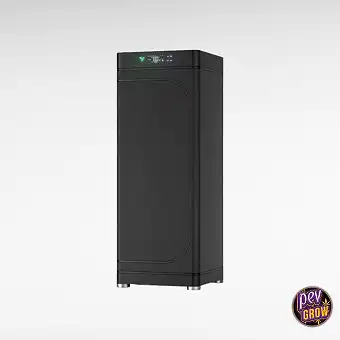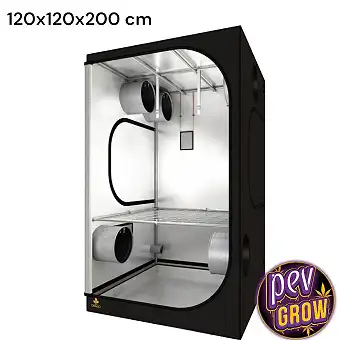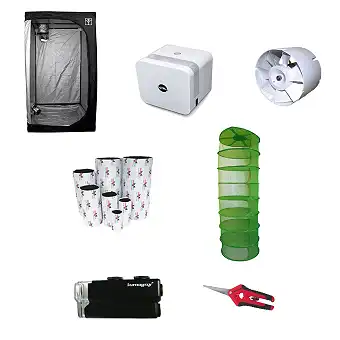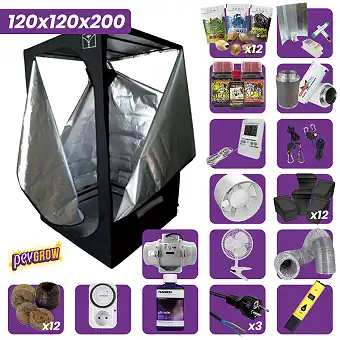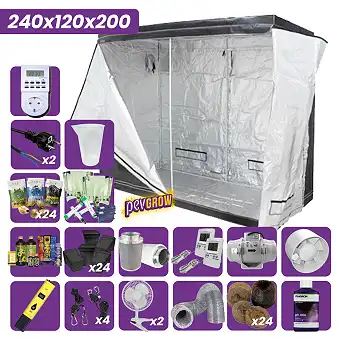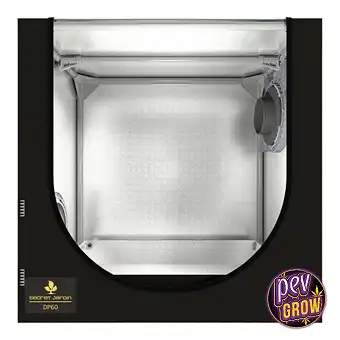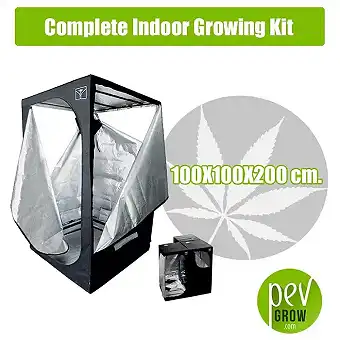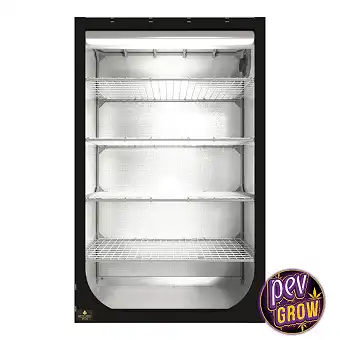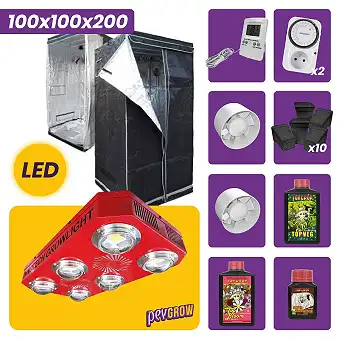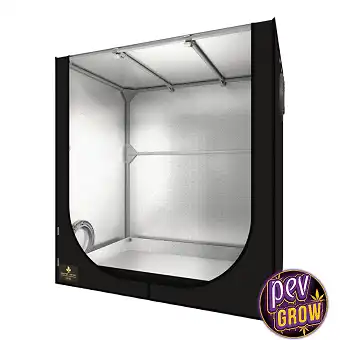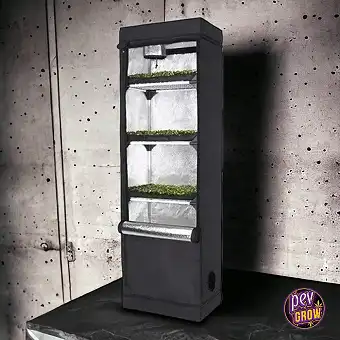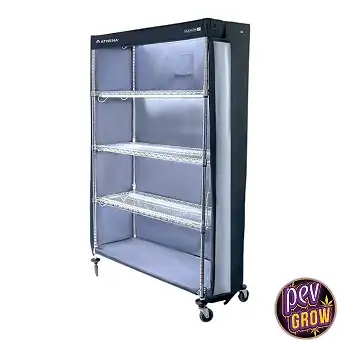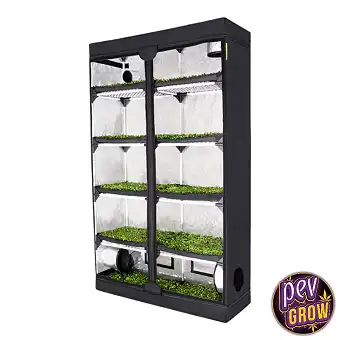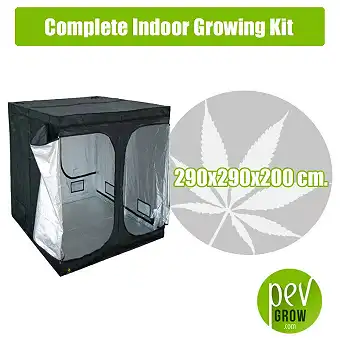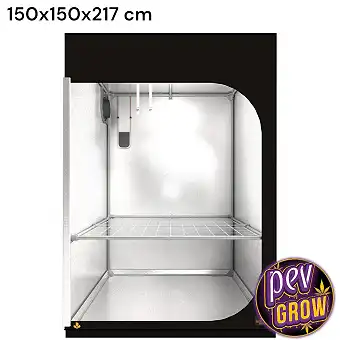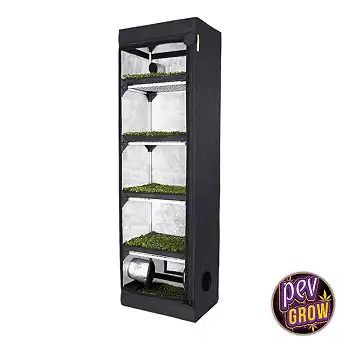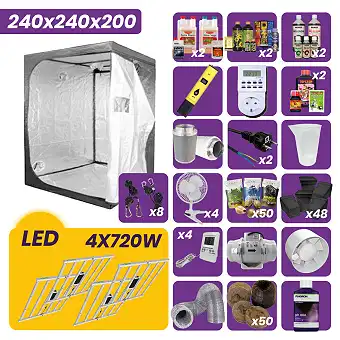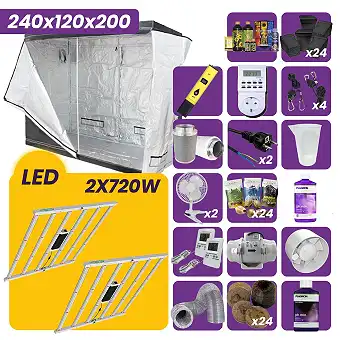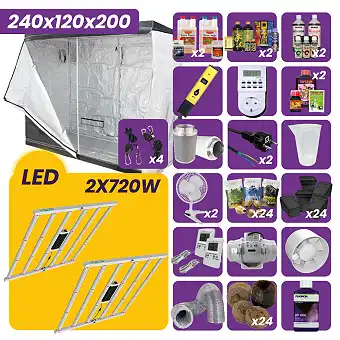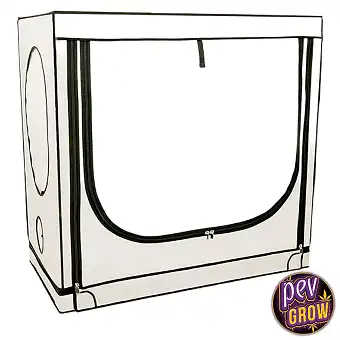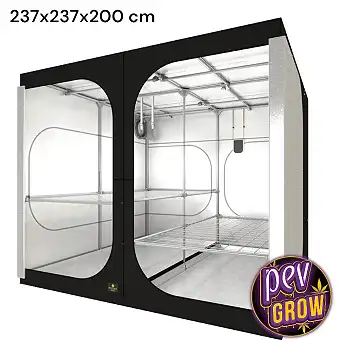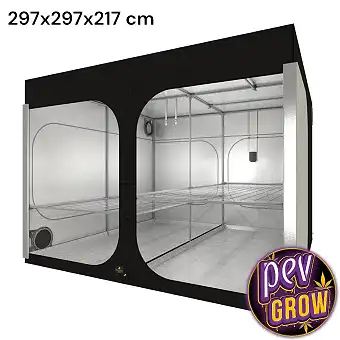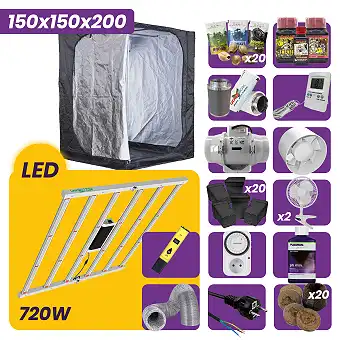Grow tents
In this category you will find the growing cabinet that you are looking for, we have all the measures, for 1, 2 or 4 lights, made by different brands and with the best prices.
Welcome to the grow tent section of Pevgrow! Here you will find a selection of the best grow tents on the market, designed to meet the needs of growers of all levels, from beginners to experts. Our grow tents offer a controlled and optimized environment so you can grow your favorite plants indoors with maximum efficiency and quality. At Pevgrow, we are committed to your success in indoor cultivation, providing high-quality products, expert advice, and competitive prices. Explore our collection and start transforming your space into a productive and healthy garden today!
Sale of the Best Grow Tents
At Pevgrow, we pride ourselves on offering a range of high-quality grow tents that cater to the needs and budgets of all growers. Our selection includes products from the most recognized brands on the market, such as Secret Jardin, Mammoth, Homebox, Spider Farmer, and many more. Each tent is designed to provide a controlled and efficient environment, optimizing the growing conditions of your plants.
Why Choose Our Grow Tents?
- Superior Quality: We work with renowned manufacturers who use durable and reflective materials, ensuring maximum light efficiency and robustness.
- Variety of Sizes and Models: From compact tents perfect for small spaces to large structures for commercial grows, we have the ideal size for every need.
- Advanced Features: Our tents come with features like sturdy zippers, access windows, adjustable ventilation ports, and Mylar interior linings to maximize light reflection.
- Ease of Assembly and Use: Designed for easy assembly, our tents come with clear instructions and all necessary components for quick and hassle-free installation.
- Expert Advice: Our team of experts is available to help you select the grow tent that best suits your needs, providing advice and support throughout the process.
What is a Grow Tent and What is it Used For?
A grow tent is a closed and controlled structure specifically designed for indoor plant cultivation. These tents provide an optimized environment that allows growers to recreate ideal growing conditions, such as lighting, temperature, humidity, and ventilation, regardless of outdoor weather conditions. They are mainly used for the cultivation of cannabis, medicinal plants, ornamental plants, and other types of plants that require specific conditions to thrive.
Main Features of a Grow Tent:
- Light Control: Light is one of the most critical factors for plant growth. Grow tents are equipped with specialized lighting systems (LED, HPS, MH) that mimic the solar spectrum and allow for the adjustment of light intensity and cycle.
- Temperature Control: Grow tents allow for maintaining a constant and suitable temperature for plant development, using heating or cooling systems if necessary.
- Humidity Control: Maintaining adequate humidity levels is essential for plant health. Grow tents are equipped with humidifiers and dehumidifiers to regulate air humidity.
- Ventilation and Air Circulation: Good airflow is crucial to avoid the buildup of heat and humidity, which can lead to mold and disease development. Air extraction and ventilation systems in grow tents ensure constant air circulation.
- Safety and Discretion: Grow tents are discreet and secure, protecting plants from pests and ensuring that the cultivation remains out of sight.
Common Applications of a Grow Tent:
- Cannabis Cultivation: Allows for total control over the light cycle and environmental conditions, optimizing the yield and quality of the buds.
- Medicinal Plants: Facilitates the growth of plants with medicinal properties in a controlled environment, ensuring their purity and potency.
- Ornamental Plants: Ideal for growing exotic and ornamental plants that require specific light and humidity conditions.
How to Assemble a Grow Tent?
Assembling a grow tent may seem like a complex task, but with proper guidance, it can be done efficiently. Below are the basic steps and some tips to ensure a successful assembly:
Steps to Assemble a Grow Tent:
- Select the Space and the Tent:
- Choose a suitable place in your home that has enough space and ventilation.
- Ensure that the size of the tent fits your needs and the available space.
- Install the Structure:
- Unpack all the tent pieces and organize the components.
- Assemble the tent frame by connecting the metal bars to the corner pieces. Ideally, assemble the pieces that make up the floor and the ceiling separately, then join both parts with the help of the vertical bars.
- Ensure that the structure is firm and stable.
- Place the Reflective Linings:
- Place the reflective lining over the metal structure, ensuring it is well-stretched and wrinkle-free. Find the floor in the lining, spread it out, place the metal structure on top, adjust the bottom part of the lining, and then stretch it to cover the top part. Then, just close the zippers to make it fully adjusted.
- These linings help maximize light reflection, optimizing plant lighting.
- Install the Lighting System:
- Select the appropriate type of lighting for your plants (LED, HPS, CFL).
- Mount the lights at the top of the tent with the help of pulleys with brakes and adjust the height according to the type of plant and its growth stage.
- Connect the cables and ensure everything is working correctly.
- Set Up Ventilation:
- Install the air extractors and intractors to maintain good circulation.
- Place internal fans to ensure air is evenly distributed inside the tent.
- Ensure that the ventilation systems work correctly to avoid heat and humidity buildup.
- Add Control Instruments:
- Place thermohygrometers to monitor temperature and humidity.
- Install electric timers to control light and dark cycles.
- Consider adding CO2 generators to optimize plant growth.
- Ensure all instruments are correctly calibrated and functioning.
Additional Tips for Assembly:
- Electrical Safety: Ensure all electrical connections are secure and use surge protectors.
- Regular Maintenance: Regularly check all systems (lighting, ventilation, climate control) to ensure they are functioning correctly.
- Cleaning and Pest Prevention: Keep the inside of the tent clean and free of debris to avoid pests and diseases.
Types of Grow Tents
60x60 cm Grow Tent
Description: Compact and efficient, ideal for small spaces like mini-apartments or small rooms.
Capacity: Suitable for 1-2 medium plants or 4 small plants like autoflowering or indica strains with little vegetative growth.
Common Uses: Perfect for beginner growers, as vegetative growth tents, or for trial grows.
Advantages: Easy to handle, low operating cost, discreet.
Disadvantages: Limited space, lower yield.
80x80x160 cm Grow Tent
Description: Slightly larger, offering more space for bigger plants.
Capacity: Ideal for 4-5 medium plants, or up to 9 small ones like autoflowering or clones of indica strains with little vegetative growth.
Common Uses: Cannabis cultivation for personal use for those who need a small amount.
Advantages: Greater height allows better plant development.
Disadvantages: Can be a bit more challenging to maintain stable temperature and humidity.
90x90 cm Grow Tent
Description: Provides a good balance between size and capacity.
Capacity: Suitable for 1 large plant, 4-5 medium plants, or up to 9 small ones like autoflowering or clones of indica strains with little vegetative growth.
Common Uses: Ideal for intermediate growers.
Advantages: Good space to work, allows the use of more powerful lighting systems.
Disadvantages: Requires a bit more space and environmental condition management.
100x100x200 cm Grow Tent
Description: A versatile size popular among serious growers.
Capacity: Can house 4-6 medium plants, 9 autoflowering plants, or up to 16 small cuttings.
Common Uses: Suitable for cannabis and medium-sized medicinal plant cultivation.
Advantages: Enough space for robust growth and advanced lighting systems.
Disadvantages: Requires greater control of ventilation and temperature.
120x60 cm Grow Tent
Description: An elongated option that allows for a more linear distribution of plants.
Capacity: Suitable for 1-2 medium plants or 4 small plants or columnar morphology plants. Several propagators with cuttings or even many magic mushroom grow kits can also be placed.
Common Uses: Cultivation of cuttings, magic mushrooms, and plants in vegetative growth.
Advantages: Good light distribution and easy access to plants.
Disadvantages: Limited vertical space.
120x120x200 cm Grow Tent
Description: Spacious and suitable for more intensive cultivation.
Capacity: Can house 9 medium plants, 16 small ones, or up to 25 clones.
Common Uses: Ideal for advanced growers looking to maximize yield.
Advantages: Ample space to work and for larger plants.
Disadvantages: Higher energy consumption and need for more environmental control equipment.
150x150x200 cm Grow Tent
Description: Large capacity for more extensive grows.
Capacity: Can house 16 medium plants, 25 small ones, or up to 36 cuttings.
Common Uses: Intensive cultivation of cannabis and medicinal plants.
Advantages: Ample space for various cultivation configurations.
Disadvantages: Requires significant investment in lighting and ventilation.
240x120x200 cm Grow Tent
Description: Double space for extensive grows.
Capacity: Can house 18 medium plants, 32 small seed plants, or up to 50 cuttings.
Common Uses: Grows for personal use for several people, family, friends, or roommates.
Advantages: Large capacity, suitable for advanced techniques like SCROG or SOG.
Disadvantages: Requires intensive management of environmental conditions.
240x240x200 cm Grow Tent
Description: Large square space for massive cultivation.
Capacity: Can house up to 36 medium plants, 64 small seed plants, or up to 100 cuttings.
Common Uses: Commercial and research grows.
Advantages: Maximum space for large yields.
Disadvantages: High demand for energy and resources to maintain optimal conditions.
290x145x200 cm Grow Tent
Description: Offers a more elongated distribution with ample space.
Capacity: Can house up to 32 medium plants, 50 small seed plants, or up to 72 cuttings.
Common Uses: Cannabis cultivation for personal use for a heavy smoker or several normal consumers.
Advantages: Ample space to maneuver and manage plants.
Disadvantages: Requires considerable physical space.
300x150x200 cm Grow Tent
Description: Elongated and spacious for large projects.
Capacity: Up to 32 medium plants, 50 small seed plants, or up to 72 cuttings.
Common Uses: Commercial cultivation and for heavy consumers.
Advantages: Large capacity, suitable for advanced cultivation techniques.
Disadvantages: High demand for control and resources.
3x3x2 m Grow Tent
Description: Cubic space of large volume for massive grows.
Capacity: Up to 64 medium plants, 100 large seed plants, or up to 144 cuttings.
Common Uses: Large-scale commercial cultivation for the legal circuit.
Advantages: Maximum space for high yields.
Disadvantages: High cost and intensive management.
240x480x240 cm Grow Tent
Description: Extensive space for very large commercial grows.
Capacity: Up to 72 medium plants, 128 small seed plants, or up to 200 cuttings.
Common Uses: Large-scale cultivation for associations, consumer clubs, dispensaries, etc.
Advantages: Enormous capacity, ideal for commercial operations.
Disadvantages: Complex management and high costs.
600x300x200 cm Grow Tent
Description: Extra-large space for industrial grows.
Capacity: Around 128 medium plants, 200 large seed plants, or up to 288 cuttings.
Common Uses: Industrial production for the legal market.
Advantages: Large production capacity.
Disadvantages: Requires significant investment in infrastructure and resources.
600x1200x240 cm Grow Tent
Description: Immense space for very large-scale grows.
Capacity: Around 512 medium plants, 800 large seed plants, or up to 1152 cuttings.
Common Uses: Massive production for broad markets.
Advantages: Very high production capacity.
Disadvantages: High logistical and operational demand.
900x450x240 cm Grow Tent
Description: Huge space for industrial cultivation projects.
Capacity: Up to 96 medium plants, 150 small seed plants, or up to 216 cuttings.
Common Uses: Industrial cultivation with high demand.
Advantages: Very high production, ideal for supplying large legal markets like Germany.
Disadvantages: High operational costs and management complexity.
750x1500x240 cm Grow Tent
Description: Industrial space of maximum capacity.
Capacity: About 1000 medium plants, 1800 small seed plants, or up to 2800 cuttings.
Common Uses: Large-scale cultivation for massive supply to dispensaries, coffeeshops, etc.
Advantages: Unmatched production capacities.
Disadvantages: Requires massive investment and complex management.
Large Grow Tents
Large grow tents are specially designed for advanced growers looking to maximize their production and yield. These tents offer enough space for multiple plants, allowing experimentation with different lighting, ventilation, and advanced cultivation techniques. Below are the features and benefits of large grow tents:
Features of Large Grow Tents:
- Ample Space: These tents provide extensive space that can accommodate a large number of plants, allowing growers to manage large-scale crops.
- Versatile Lighting Configurations: With enough space, multiple lighting systems (LED, HPS, MH) can be installed to ensure uniform coverage and optimize plant growth.
- Complete Ventilation System: Air circulation is crucial in large spaces. These tents usually include multiple air extractors, oscillating fans, and anti-odor carbon filters to keep the environment fresh and odor-free.
- Accessibility: Large tents often have additional doors and windows to facilitate access to all plants without disturbing the overall environment.
- Environmental Control: Equipped with advanced temperature and humidity control systems, these tents allow precise adjustment of growing conditions.
Benefits of Large Grow Tents:
- Maximization of Yield: With more space and better control, growers can maximize the yield and quality of their harvest.
- Flexibility in Cultivation: They allow the implementation of advanced techniques and the integration of hydroponic or aeroponic systems.
- Operational Efficiency: Although they require a higher initial investment, large tents can be more efficient in the long term in terms of production and resource use.
LED Grow Tents
Complete LED indoor grow tent kits have gained popularity due to their energy efficiency and ability to emit less heat compared to other light sources. Below are the advantages and specific features of these tents:
Features of LED Grow Tents:
- Energy Efficiency: LED lights consume less electricity than HPS or MH lamps, resulting in lower operating costs.
- Low Heat Emission: They emit less heat, helping to maintain optimal temperatures inside the tent and reducing the need for additional cooling systems.
- Adjustable Light Spectrum: Many LED systems allow adjusting the light spectrum to suit the different stages of plant growth (vegetative and flowering).
- Durability: LED lights have a longer lifespan, reducing the frequency of replacement and maintenance.
Benefits of LED Grow Tents:
- Cost Reduction: Lower energy consumption and less need for cooling systems.
- Better Environmental Control: Facilitates the maintenance of stable conditions inside the tent, improving plant health and growth.
- Adaptability: Ideal for all types of plants and cultivation techniques, from cannabis to ornamental and medicinal plants.
Clone Tents
Clone tents are specifically designed for the cloning of cannabis plants and maintenance of mother plants. They maintain optimal humidity and temperature conditions to ensure rooting and healthy growth of cuttings.
Features of Clone Tents:
- Controlled Environment: These tents maintain high humidity levels (around 70-80%) and a constant temperature (between 20-25°C) to favor rooting.
- Soft Lighting: They use fluorescent or low-intensity LED lights that provide just the right amount of light without damaging the cuttings.
- Efficient Space: Designed to maximize the number of cuttings in a small space, with special trays and supports.
Benefits of Clone Tents:
- High Success Rate: Optimal conditions ensure a high success rate in plant cloning.
- Accelerated Growth: Controlled environments accelerate the rooting process and initial growth.
- Ease of Use: Ideal for professional and amateur propagators, simplifying the cloning process.
Mushroom Grow Tents
Mushroom grow tents are specifically designed to create the perfect environment for the development of mycelium and the fruiting of mushrooms.
Features of Mushroom Grow Tents:
- Humidity Control: Equipped with humidifiers and dehumidifiers to maintain a constant humidity (around 90-95%).
- Constant Temperature: Maintain an optimal temperature (between 22-25°C) for mushroom growth.
- Sterile Environment: Designed to minimize contamination and maintain a sterile environment.
Benefits of Mushroom Grow Tents:
- Optimal Growth: Precise conditions favor healthy development and the production of high-quality mushrooms.
- Contamination Reduction: Controlled environments significantly reduce the risk of mold and bacterial contamination.
- Ease of Use: Simplify the cultivation process, making it accessible for both beginners and experts.
Complete Indoor Grow Tents
The complete indoor grow tents are all-in-one kits that include all the necessary components to start growing immediately. These kits are ideal for beginners and those who want a comprehensive growing solution.
Components of Complete Indoor Grow Tents:
- Grow tent of choice: Made with durable materials and available in many different sizes.
- Lighting System: Includes LED, HPS, or CFL lights, along with ballasts and reflectors.
- Ventilation System: Extractors, intractors, and fans to ensure good air circulation.
- Pots and Substrates: Pots of different sizes and substrates suitable for the type of plant.
- Nutrients and Fertilizers: Specific formulas for each stage of plant growth.
- Control Instruments: Thermohygrometers, timers, and pH and EC meters.
Benefits of Complete Indoor Grow Tents:
- Ease of Setup: Everything you need in one package, simplifying the installation process.
- Guaranteed Compatibility: Components selected to work together optimally.
- Ideal for Beginners: They offer a complete solution that eliminates the need to search for and combine components separately.
- Time and Money Saving: Buy everything in one place, often with package discounts.
The Best Brands of Grow Tents
Choosing a high-quality grow tent brand is crucial to ensure an optimal environment for your plants' growth. Here are some of the best brands available on the market, known for their durability, innovative design, and efficiency.
1. Secret Jardin
Description: Founded in 2006, Secret Jardin is a Belgian brand that has stood out for its high-quality products in the indoor growing field. The Secret Jardin grow tents offer excellent value for money.
Main Features:
- High-Quality Reflective Materials: They use Mylar 210D, which guarantees excellent light reflection.
- Modular Design: Easy to assemble and adjust according to the grower's needs.
- Accessories: They offer a wide range of compatible accessories, such as ventilation kits and lighting systems.
Advantages:
- High durability and robustness.
- Excellent light reflection capacity.
- Easy to assemble and disassemble.
2. Mammoth
Description: Mammoth is a Dutch brand recognized for its innovation and quality in grow tent design.
Main Features:
- Solid Structure: Robust and resistant metal frames.
- Quality Materials: Reflective Mylar interior canvases.
- Variety of Sizes: From small tents for personal use to large structures for commercial grows.
Advantages:
- Wide variety of sizes and models.
- Durable and high-quality materials.
- Good technical support and customer service.
3. Homebox
Description: Homebox is a German brand pioneering in the manufacture of grow tents, known for its commitment to quality and innovation.
Main Features:
- PAR+ Technology: Interior materials that increase the reflection of useful light for plants.
- Solid Structures: Robust metal tubes and durable connectors.
- Efficient Ventilation Systems: Designed to maximize air circulation.
Advantages:
- Advanced light reflection technology.
- Robust and easy-to-assemble design.
- Excellent temperature and humidity control.
4. Spider Farmer
Description: Known primarily for their LED lighting systems, Spider Farmer also produces high-quality grow tents.
Main Features:
- Integrated Lighting: Many of their tents come with pre-installed LED lights.
- Reflective Material: Mylar interior canvases that maximize light reflection.
- Compact Design: Ideal for small and medium spaces.
Advantages:
- Perfect integration with LED lighting systems.
- High energy efficiency.
- Easy to assemble and maintain.
5. Dark Room
Description: Dark Room is a sub-brand of Secret Jardin, specializing in high-end grow tents.
Main Features:
- Premium Reflective Material: They use highly reflective and resistant Mylar.
- Robust Structure: High-quality metal tubes for greater stability.
- Wide Range of Sizes: From small tents for beginners to large structures for professionals.
Advantages:
- High durability and performance.
- Easy assembly and disassembly.
- Excellent control of internal conditions.
6. Athena
Description: Athena is a brand that combines quality with advanced technology to offer efficient and durable grow tents.
Main Features:
- Advanced Technology: Integration of advanced environmental control systems.
- High-Quality Materials: Durable and reflective structures and canvases.
- Ergonomic Design: Easy access and handling of plants.
Advantages:
- High efficiency in controlling the growing environment.
- Resistant and durable materials.
- Excellent technical support.
7. Pure Tent
Description: Pure Tent specializes in grow tents that combine quality with affordable prices.
Main Features:
- Quality Reflective Materials: Use of Mylar to maximize light.
- Simple but Solid Structure: Designs that facilitate assembly and stability.
- Compatible Accessories: Variety of accessories to improve growing performance.
Advantages:
- Good value for money.
- Easy to assemble and handle.
- Durable materials.
8. Cultibox
Description: Cultibox offers a wide range of grow tents designed for different levels of experience and needs.
Main Features:
- Modular Design: Facilitates expansion and modification according to the grower's needs.
- Reflective Material: Mylar interior canvases for better light reflection.
- Good Ventilation: Well-designed ventilation systems to ensure constant airflow.
Advantages:
- Flexibility and adaptability.
- Good value for money.
- Easy access and handling of plants.
Products that Complete the Grow Tents
Lighting Systems
Lighting is one of the most crucial components in a grow tent. Choosing the right light can make a big difference in the health and performance of the plants.
1. LED Grow Lights
Advantages:
- Energy Efficiency: Consume less electricity and generate less heat, reducing cooling costs.
- Adjustable Spectrum: Many LED lights allow you to adjust the spectrum to suit different growth stages.
- Long Lifespan: LED lights have a longer lifespan than other types of lighting.
Disadvantages:
- Initial Cost: Although efficient in the long run, LED lights can have a higher initial cost.
Popular Examples:
- Spider Farmer SF Series: Known for their high efficiency and excellent performance.
- Lumatek Zeus Pro: Offer a good balance between price and performance.
2. HPS Lighting
Advantages:
- High Light Intensity: Ideal for the flowering stage, promoting robust bud development.
- Lower Initial Cost: Generally cheaper than LED lights.
Disadvantages:
- High Heat Emission: Require robust ventilation systems to dissipate heat.
- Energy Consumption: Consume more electricity than LED lights.
Popular Examples:
- Lumatek HPS: Known for their high quality and durability.
- Sunmaster HPS: Offer an optimized light spectrum for flowering.
3. MH Lighting
Advantages:
- Blue Light Spectrum: Ideal for the vegetative stage, promoting robust plant growth.
Disadvantages:
- High Heat Emission: Like HPS, they require good ventilation.
- Energy Consumption: Similar to HPS, they consume more electricity.
Popular Examples:
- Lumatek MH: Known for their quality and consistent performance.
- SunMaster Veggie: Offer an optimized spectrum for vegetative growth.
Ventilation
An adequate ventilation system is essential to maintain optimal conditions inside the grow tent, ensuring constant airflow and eliminating excess heat and humidity.
1. Air Extractors
Description: Extract hot and stale air from inside the tent and, when reversed, bring fresh air loaded with CO2 into the indoor grow.
Advantages:
- Temperature Control: Help maintain the proper temperature.
- Humidity Reduction: Prevent mold and fungus problems.
Popular Examples:
- RVK: Known for their durability and efficiency.
- Prima-Klima: Offer robust and reliable performance.
2. Fans
Description: Circulate the air inside the tent to prevent hot spots and improve plant strength.
Advantages:
- Mold Prevention: Help keep the air moving, reducing stagnant humidity.
- Plant Strengthening: Air movement simulates natural conditions, strengthening stems.
Popular Examples:
Climate Controllers
Maintaining precise control over the climate inside the tent is vital for the healthy growth of plants. The following climate controllers help achieve this:
1. Humidifiers
Description: Increase the relative humidity inside the tent.
Advantages:
- Better Humidity for Growth: Maintain optimal humidity levels, especially during the vegetative stage.
Popular Examples:
2. Dehumidifiers
Description: Reduce excessive humidity to prevent mold and fungus problems.
Advantages:
- Mold Prevention: Maintain a dry and healthy environment.
Popular Examples:
- VDL Drybox: Compact and efficient.
- Quest Dual: High capacity and consistent performance.
3. Thermohygrometers
Description: Monitor the temperature and humidity inside the tent.
Advantages:
- Constant Monitoring: Allow real-time adjustment of conditions.
Popular Examples:
- Mammoth XXL: Accurate, with a large screen, and easy to use.
- VDL without probe: Reliable and economical.
Pots and Substrates
The outdoor and indoor pots and the substrates for weed are essential to provide the ideal growing environment for plant roots.
1. Pots of Different Sizes
Description: Variety of sizes to suit different stages of plant growth.
Advantages:
- Adequate Space for Roots: Allow healthy root system development.
Popular Examples:
- Smart Pots: Fabric that aerates the roots and improves drainage.
- Air-Pots: Design that prevents root tangling and promotes vigorous growth.
2. Types of Soil or Hydroponics
Description: Substrates like soil, coco, perlite, vermiculite, and hydroponic systems.
Advantages:
- Optimal Substrate for Each Type of Plant: Different substrates for different growing needs.
Popular Examples:
- All Mix by Biobizz: Rich in nutrients, ideal for a wide variety of plants.
- Canna Coco: Coco substrate that offers excellent aeration and water retention.
Nutrients and Fertilizers
Providing plants with the fertilizers for weed at each stage of their growth is vital for obtaining a bountiful and healthy harvest.
1. Specialized Nutrients and Fertilizers for Each Growth Stage
Description: Fertilizers specifically formulated for the vegetative and flowering stages.
Advantages:
- Optimal Growth: Provide essential nutrients tailored to the specific needs of each stage.
Popular Examples:
- Canna: Liquid nutrients for all types of plants and substrates.
- Advanced Nutrients: Specific formulas for each phase of development.
2. Additives and Supplements
Description: Products that enhance nutrient absorption and plant vigor.
Advantages:
- Improvement of Overall Plant Health: Supplements like mycorrhizae, enzymes, and vitamins strengthen plants and improve their resistance to diseases.
Popular Examples:
- Great White Mycorrhizae: Improves nutrient absorption and root health.
- House & Garden Root Excelurator: Stimulates root growth and improves disease resistance.
How to Choose the Best Grow Tent
Choosing the right grow tent is crucial to ensure an optimal environment for your plants' growth. This process involves considering several important factors that will directly impact the success of your cultivation. Below are the key aspects you should consider when selecting the best grow tent for your needs.
1. Available Space
Space Measurement:
- Dimensions: Carefully measure the area where you plan to place the grow tent. Consider not only the length and width but also the available height.
- Accessibility: Ensure there is enough space to open and access the tent comfortably, as well as for the installation of ventilation systems and other equipment.
- Location: Consider the location in relation to water and electricity sources, as well as ease of access for maintenance and monitoring.
Additional Considerations:
- Natural Ventilation: If possible, choose a space with good natural ventilation to complement the tent's ventilation systems.
- Ambient Temperature: Avoid placing the tent in areas where temperatures fluctuate drastically, such as unheated garages.
2. Type and Quantity of Plants
Species and Growth Stages:
- Types of Plants: Determine what type of plants you will grow. Some plants require more vertical space, while others may need more horizontal space.
- Number of Plants: Decide how many plants you will grow. This will influence the size of the tent you need. Keep in mind that overcrowding can negatively affect plant growth and health.
Stage Planning:
- Vegetative and Flowering: Some species need different conditions for the vegetative and flowering stages. Ensure the tent can adapt to these changes.
- Harvest Rotation: If you plan to have continuous harvests, consider a tent large enough to handle multiple growth stages simultaneously.
3. Budget
Initial and Ongoing Costs:
- Tent: Consider the cost of the tent itself. Prices can vary significantly depending on size and features.
- Complementary Equipment: Factor in the cost of lighting systems, ventilation, climate controllers, pots, substrates, nutrients, and other necessary accessories.
- Operating Costs: Consider the costs of electricity, water, and regular maintenance. LED lighting systems, although more expensive initially, can save money in the long run compared to HPS due to their energy efficiency.
Quality and Durability:
- Materials: Investing in a high-quality tent made with durable materials may be more expensive initially but can save money in the long run by reducing the need for replacements and repairs.
- Warranty and Support: Check if the manufacturer offers warranties or technical support. This can be an important factor if you encounter problems with the tent or its components.
4. Additional Features
Design and Functionality:
- Access Windows: Access windows allow you to check the status of the plants without altering the internal environment of the tent, which is crucial for maintaining stable conditions.
- Robust Zippers: High-quality zippers ensure greater durability and better sealing to maintain internal conditions.
- Ventilation Ports: Ensure the tent has enough ports to install ventilation systems and electrical cables without compromising the structure.
- Reflectivity: Highly reflective Mylar interior linings are essential to maximize lighting efficiency, ensuring plants receive the necessary light from all angles.
Ventilation and Filtration Configurations:
- Inlet and Outlet Holes: Should be adjustable to accommodate different sizes of ventilation tubes and ensure optimal airflow.
- Compatibility with Carbon Filters: Activated carbon filters are essential for odor control. Ensure the tent is compatible with these filters and has a good sealing system to keep odors inside.
Ease of Assembly and Disassembly:
- Clear Instruction Manual: A good instruction manual makes the assembly process easier.
- Necessary Tools: Check if the tent requires additional tools for assembly or if it comes with everything needed. Normally, it does not need them.
Accessories and Complements:
- Drainage Trays: Drainage trays help manage excess water and keep the interior of the tent clean.
- Hooks and Supports: For safely hanging lights and fans.
- Automatic Controllers: Timers and controllers that automatically regulate lighting, ventilation, and irrigation.
Additional Tips for Choosing the Best Grow Tent
Compatibility with Technology:
- Hydroponic Systems: If you plan to use hydroponics, ensure the tent has the space and features necessary to accommodate these systems.
- Automation: Consider compatibility with automation systems like UCI controllers that can facilitate environmental control.
Safety and Discretion:
- Electrical Safety: Ensure the tent and electrical equipment are safe and meet safety standards.
- Discretion: If privacy is a concern, choose a tent that is discreet and has insulation features to reduce noise and emitted light.
Sustainability:
- Eco-Friendly Materials: Consider tents made with sustainable and non-toxic materials.
- Energy Efficiency: Opt for equipment and systems that reduce energy and water consumption, contributing to more sustainable cultivation.
Tips for Using the Grow Tent
Using a grow tent effectively requires more than just setting it up and turning on the lights. To maximize yield and ensure the health of your plants, it is essential to maintain a controlled environment and perform regular maintenance. Below are detailed tips on how to optimize the use of your grow tent.
1. Regular Cleaning
Importance of Cleaning:
- Prevention of Pests and Diseases: A clean environment reduces the risk of pest infestations and fungal or bacterial diseases.
- Better Plant Health: Plants thrive in a clean environment where nutrients and light are not blocked by debris.
Steps to Maintain Cleanliness:
- Weekly Cleaning: Clean the interior of the tent, including the reflective walls, with a mild soap and water solution. Rinse well to avoid soap residue.
- Tool Cleaning: Disinfect pruning tools and any other equipment that comes into contact with the plants.
- Waste Management: Remove dead leaves, plant debris, and other organic waste that can attract pests or foster mold growth.
- Spill Control: Use drainage trays and ensure there is no accumulation of standing water, which can be a breeding ground for mold and fungi.
2. Constant Monitoring
Daily Review:
- Environmental Conditions: Check daily temperature, humidity, and CO2 levels. Use thermohygrometers and CO2 controllers to monitor and adjust conditions.
- Light Cycles: Ensure light timers are working correctly and adjust light cycles according to the plant growth stage.
Plant Observation:
- Signs of Stress: Look for signs of stress in plants, such as yellow leaves, spots, or abnormal growth, and adjust conditions as necessary.
- Pests and Diseases: Regularly inspect plants for pests like mites, aphids, or mold. Use organic or chemical pest control methods as needed.
Records and Documentation:
- Keep a Journal: Maintain a daily record of environmental conditions, plant observations, and any changes made. This will help identify patterns and adjust the environment effectively.
- Data Analysis: Periodically review your records to evaluate cultivation progress and make adjustments based on historical data.
3. Equipment Maintenance
Lighting Systems:
- Bulb Inspection: HPS and MH bulbs should be regularly inspected and replaced according to the manufacturer's recommendations, as their effectiveness decreases over time.
- Cleaning Fixtures: Clean reflectors and bulbs or LED panels to ensure light is not obstructed by dust or dirt.
- Inspection of Cables and Connections: Check for loose or damaged cables that could cause short circuits or fires.
Ventilation Systems:
- Filter Cleaning: Clean or replace the odor filter sleeve to ensure proper airflow.
- Fan and Extractor Inspection: Ensure fans and extractors operate smoothly and do not emit abnormal noises.
- Duct Check: Inspect ventilation ducts for blockages or leaks and repair as necessary.
Climate Controllers:
- Regular Calibration: Regularly calibrate meters to ensure accurate readings.
- Humidifier and Dehumidifier Inspection: Clean water tanks and ensure devices work correctly to maintain appropriate humidity levels.
Irrigation and Nutrients:
- Irrigation System: If using an automated irrigation system, regularly check that hoses and emitters are not blocked and that the system works correctly.
- pH and EC Control: Regularly monitor and adjust the pH and electrical conductivity (EC) of water and nutrient solutions to ensure optimal nutrient absorption.
- Nutrient Storage: Store fertilizers and supplements in a cool, dry place to maintain their effectiveness.
Additional Tips for Efficient Use of the Grow Tent
Plant Rotation and Spacing:
Regular Rotation:
Rotate the plants within the grow tent to ensure even light exposure and prevent shaded areas. Typically, plants located in the center receive more light than those on the perimeter, keep this in mind.
Proper Spacing:
Maintain adequate spacing between the plants to allow good airflow and reduce the risk of diseases. If you see that the leaves of the plants touch each other, try to avoid it because this can cause the appearance of mold due to poor ventilation.
Training and Pruning:
Regular Pruning:
Remove dead or damaged leaves and perform strategic pruning to promote healthy growth and improve light penetration. Here you can see the different cannabis pruning techniques.
Plant Training:
Use training techniques such as LST (Low Stress Training) or SCROG (Screen of Green) to maximize space and production.
Light Cycle Optimization:
Correct Photoperiod:
Adjust the light/dark cycle according to the growth stage of the plants (for example, 18/6 for vegetative and 12/12 for flowering). If they are autoflowering strains, the ideal is to set a continuous photoperiod of 20/4, that is, 20 hours of light and 4 of darkness.
Quality Light:
Use lamps that emit the appropriate spectrum for each phase of plant growth, ensuring they receive the necessary intensity and type of light. If you don't want to change the light, you should know that full-spectrum LED grow lights emit a type of light that is suitable for all growth phases.
Sustainability and Energy Saving:
Energy Efficiency:
Opt for energy-efficient lighting and ventilation systems to reduce operating costs. In this article from our blog, you will see some ideas to save on indoor cannabis cultivation.
Substrate Reuse:
Consider methods to safely and sustainably reuse substrates, such as composting or soil revitalization. By mixing Biobizz Pre-Mix with used substrate, you can revitalize the soil for reuse.
Advanced Monitoring and Automation:
Remote Monitoring Systems:
Use controllers with monitoring systems that allow you to check the conditions of the grow tent from your smartphone or computer.
Automation:
Implement automated systems for irrigation, lighting, and ventilation to reduce manual intervention and ensure constant optimal conditions.
Conclusions
Grow tents represent an advanced and efficient solution for indoor plant cultivation, providing a controlled environment that allows growers to maximize the potential of their plants. These tents not only offer the flexibility needed to adjust growth conditions according to the specific needs of each plant but also ensure high-quality production regardless of external conditions.
Buy Cheap Grow Tents at Pevgrow
At Pevgrow, we pride ourselves on offering a wide selection of high-quality grow tents at competitive prices. We understand that both beginner and experienced growers have unique needs, so our range of products is designed to meet a variety of requirements and budgets.
FAQs Related to Grow Tents
Is it legal to have a grow tent?
The legality of having a grow tent depends on the laws and regulations of each country or region. In many places, it is perfectly legal to own and use a grow tent for growing ornamental plants, vegetables, and medicinal herbs. However, if you plan to grow weed or other controlled plants, it is crucial to check local laws, as they can vary significantly. In some places, growing weed is allowed for personal or medicinal use, while in others it remains illegal. Always consult local regulations before starting your growing project.
How to grow in an indoor grow tent?
Growing in an indoor grow tent involves several key steps, which would be too long to explain here, but you can read our marijuana growing guide on our blog. However, here are a few key points:
Preparing the Grow Tent:
- Assembly: Assemble the grow tent according to the manufacturer's instructions.
- Light Installation: Place the appropriate lights (LED, HPS, MH) and adjust their height according to the plants' needs.
- Ventilation: Install extractors, intractors, and fans to ensure good air circulation.
Choosing the Plants:
Select plants that adapt well to indoor growing and have similar light, water, and nutrient requirements.
Planting and Care:
- Planting: Plant your seeds or cuttings in suitable substrate or a hydroponic system.
- Watering and Nutrition: Water and fertilize according to the plants' needs. Monitor and adjust the pH and EC levels of the water.
- Monitoring: Check daily the conditions of temperature, humidity, and light. Adjust as necessary.
Climate Control:
Use thermohygrometers to monitor the internal climate and adjust humidifiers, dehumidifiers, and CO2 controllers to maintain optimal conditions.
How does a grow tent work?
A grow tent functions as a controlled environment that mimics the optimal conditions for plant growth. Here are the main components and their functions:
- Structure and Reflective Linings: The structure of the grow tent is lined with reflective material to maximize available light.
- Lighting System: Provides the necessary light for photosynthesis. The intensity and light spectrum can be adjusted according to the plants' needs.
- Ventilation System: Includes air extractors and intractors to maintain fresh air flow and remove excess heat and humidity.
- Climate Controllers: Thermohygrometers, humidifiers, dehumidifiers, and CO2 controllers keep temperature and humidity at optimal levels.
- Substrate and Watering: Plants grow in suitable substrates or hydroponic systems with automated watering.
How to make a homemade grow tent?
Building a homemade grow tent is a rewarding project. Here is a basic guide:
Necessary Materials:
- Structure: It can be an old cabinet, sturdy shelves, or build a wooden structure.
- Reflective Linings: Mylar or white paint for the internal walls.
- Lighting System: LED, HPS, or CFL lights.
- Ventilation: Extractors, intractors, and fans.
- Climate Controllers: Thermohygrometers, humidifiers, and dehumidifiers.
- Accessories: Cables, timers, hooks, and supports.
If you want more information, this article explains how to build your own homemade grow tent.
Steps to Follow:
- Building the Structure: Ensure the structure is stable and of adequate size.
- Reflective Lining: Line the internal walls with Mylar or paint with white paint.
- Light and Ventilation Installation: Mount the lights at the top and the fans/extractors on the sides to ensure good air flow.
- Climate Control System: Install the climate controllers and adjust according to the plants' needs.
How to install an extractor in a grow tent?
Installing an extractor is essential to maintain adequate air flow. Here’s how to do it:
- Choose the Location: Generally, extractors are installed at the top of the grow tent to extract the hot air that rises.
- Cut Ports: If your grow tent does not have pre-installed ports, cut a hole of the appropriate size for the extractor.
- Mount the Extractor: Secure the extractor in the hole with screws and ensure it is well fastened.
- Connect Ducts: Connect air ducts that carry the extracted air out of the growing area.
- Test: Turn on the extractor to ensure it is working correctly and adjust the speed if necessary.
If you have doubts about which extractors to choose, this article explains how to calculate the necessary air flow for indoor cultivation.
How much does a grow tent consume?
The energy consumption of a grow tent depends on several factors, including the size of the tent, the type of lighting, and the ventilation systems. Here is an approximate breakdown:
- LED Lighting: Generally between 100W and 1000W, depending on the size and type of light.
- HPS Lighting: Can vary from 250W to 1000W.
- Ventilation: Extractors and fans can consume between 20W and 100W each.
- Climate Controllers: Humidifiers, dehumidifiers, and CO2 controllers also consume additional energy, but adding everything can increase by about 200W at most.
Example Calculation:
A grow tent with a 300W LED, two 50W fans, and a 100W extractor:
- Daily Total: 300W (LED) + 2 x 50W (fans) + 100W (extractor) = 500W.
- Monthly Consumption: 500W x 18 hours a day x 30 days = 270 kWh.
How to lower the humidity in my grow tent?
To reduce humidity in your grow tent, follow these tips:
- Use a Dehumidifier: Install a dehumidifier suitable for the size of your grow tent.
- Increase Ventilation: Increase the speed of the fans and ensure fresh air enters and humid air exits.
- Improve Drainage: Ensure there is no standing water in the drainage trays.
- Control Watering: Do not overwater and consider watering when the lights are on to promote evaporation.
- Remove Excess Foliage: Prune unnecessary leaves that can retain moisture.
If you want to delve deeper into this topic, don't miss this article that explains how to lower the humidity in the indoor grow tent.
How to cool a grow tent?
To keep your grow tent at an adequate temperature, follow these steps:
- Install Powerful Extractors: Improve the extraction system to remove hot air more efficiently.
- Use Air Conditioning: If the ambient temperature is high, consider using a portable air conditioning unit.
- LED Lighting: Switch to LED lights, which generate less heat than HPS.
- Night Light Cycle: Schedule the light cycle so that the lights are on at night when temperatures are lower.
- Additional Fans: Add more fans to increase air flow inside the grow tent.
Where to place the fan in a grow tent?
The proper placement of fans is crucial for good air circulation:
- Oscillating Fans: Place oscillating fans on the sides of the grow tent, at a medium height to move air through the plants without damaging the leaves.
- Top Fan: Place a fan at the top to move hot air towards the extractors.
- Bottom Fan: Place one at the bottom to ensure fresh air reaches the base of the plants.
What grow tent to buy?
The choice of grow tent depends on several factors:
- Size and Available Space: Measure the space where you will place the grow tent and choose a size that fits comfortably.
- Type of Plants: Consider the specific needs of the plants you want to grow, such as vertical space for tall plants.
- Budget: Evaluate your budget and look for options that offer the best value for money.
- Additional Features: Look for grow tents with features like sturdy zippers, access windows, and ventilation ports.
- Recommended Brands: Some of the best brands include Secret Jardin, Mammoth, Homebox, and Spider Farmer, known for their durability and efficiency.
Among all of you who comment or send us your questions there will be a bimonthly draw for a 50 euros voucher to buy in Pevgrow. What are you waiting for? Write now and participate!





